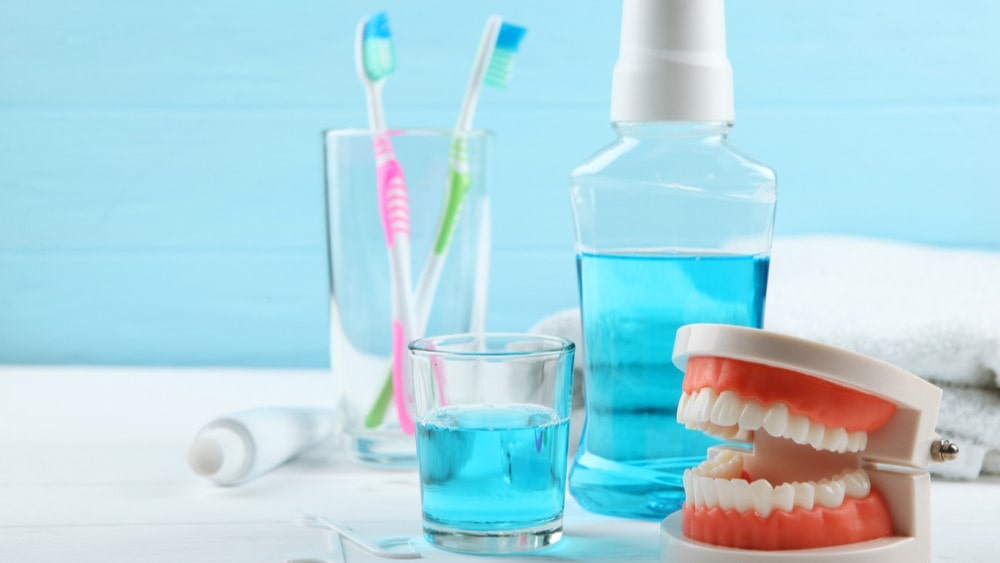Toothpaste: These are also known as oral dentifrice („dens‟-tooth, „fricare‟-to rub) designed to clean and remove plaque and stains from the teeth and keep the breath fresh.
It improves the mechanical brushing and cleaning power of a toothbrush. These are available in the product form of powders, paste, and gels.
In the beginning, it consists of a mild detergent for cleaning the teeth intended to freshen the breath and remove deposits from teeth.
Mouthwash: These are also known as oral or mouth rins. Mouthwash is designed as a clear liquid or colored solution to refresh the breath by swishing the product around the mouth, followed by spitting it out.
- It is generally intended for use after brushing to provide a more effective cleaning effect.
- Teeth whitening products: These are also known as bleaching products, and are utilized to get teeth brighter.
- There are a number of product types available in the market, including toothpaste, gels, mouthwashes, trays with a solution, and strips. These products contain various ingredients to remove discoloration of the teeth.
Other products: It includes toothpaste and dental floss. Tooth powder is an alternative to toothpaste and it was the original commercial pharmaceutical product sold for cleaning teeth as dentifrice known as camphorated chalk.
It is a mild abrasive powder i.e. used with or without a toothbrush. Its effect is similar to that of toothpaste;
however, the dosage form and mouth feel are different.
Table of Contents
TOOTHPASTE
Definition of Toothpaste
Dentifrices such as toothpaste, tooth powders, and tooth gels are meant for cleaning the surface of the teeth by removing the food debris and plaque adhered to the surface of the teeth which is the main cause of tooth problems.
- This is the primary purpose of toothpaste as a “cosmetic function.‟ The secondary function is used as a vehicle for certain therapeutic agents (e.g., fluoride against caries) in the prevention or treatment of teeth and gum diseases.
Ideal properties of toothpaste
- When used properly with an efficient toothbrush, it should adequately remove food debris, plaque, and stains from the teeth.
- It should provide a fresh and clean sensation after every use.
- Its cost should be economical to encourage regular and frequent use by all.
- It should be harmless, non-toxic, pleasant, and convenient to use.
- It should foam well, be non-sticky, and have a good texture and homogeneous color.
- It should be capable of being packed economically and have an attractive appearance.
- It should be stable in storage during its commercial shelf-life.
- It should conform to accepted national standards for its abrasive to enamel and dentine.
- Technical qualities: Long-term stability.
- Appropriate rheological qualities.
- Appropriate texture.
Formulation Ingredients/Building blocks/Raw materials
- Toothpaste is the most popular form of dentifrices and the key ingredients of its formulation determine the quality and efficiency of toothpaste.
- They are formulated by combining multiple ingredients generally, all ingredients selected in the formulation are approved for use in foodstuff and are special grades available for dental preparations, especially abrasives.
- Water (20-40%),
- Abrasives (20-50%),
- Surfactants (1-3%)
- Humectants (20-35%),
- Binding or gelling agents (1-2%),
- Sweetening agents (0-2%)
- Flavoring agents (0-2%)
- Minor ingredients include colors (0.05-0.5%), preservatives (0.05- 0.5%), whitening agents, sparkles, and pH regulators.
WATER: It is the common vehicle and is used in the deionized form in the formulation of toothpaste formulations.
- It can be used either as a solvent for the soluble components and mix the miscible liquids of the formulation or as a supporting media for the binding agents.
- Binding agents swell after imbibing water and disperse easily to achieve the desired consistency.
- It is used in concentrations of more than 10% in the formulation of clear gels.
ABRASIVES (Cleaning and polishing agents):
- The main function of abrasive is to remove food debris and residual stains from the surface of the teeth and polish the tooth surface.
- They are often used in concentrations of about 20-50% of the total formulation.
- Calcium carbonate (CaCO3, calcite or aragonite), Aluminum hydroxide Al(OH)3, Silica (SiO) Dental grade.
SURFACTANTS (cleaning and foaming agent): In toothpaste, surfactants help clean the teeth by removing food residues and plaque.
- The mechanism of cleansing action is by reducing the surface tension at the interface of the adhered material and enamel of the teeth.
- They also provide the secondary benefits of providing foam, used at a concentration of around 1-3%.
- Ex: Sodium lauryl sulfate (SLS), Sodium alkyl benzene sulfonate, 1) Sodium dodecyl benzene sulfonate, 2) Magnesium lauryl sulfate.
HUMECTANTS: Humectants are used in order to prevent the rapid drying of dentifrices and at the same time give some degree of plasticity to the paste.
- They prevent excessive moisture loss from the product. The amount of humectant loading in the formula may vary from 5 or 10% to as high as 30% by weight.
- Ex: Glycerin: It produces shiny, glossy products. It is one of the best humectants because of its stability, non-toxic, and provides sweetness to the product. It is easily available both from natural and synthetic sources but is quite expensive.
- Sorbitol: Sorbitol syrup (approximately 70%) is extensively used in many toothpaste formulations which imparts a cool sensation in the mouth and may also enhance the sweetening property.
- Propylene glycol and polyethylene glycol: These are not routinely used as the sole humectant in toothpaste since they are more expensive.
BINDING OR GELLING AGENTS: Binding or gelling agents are hydrophilic (water-loving) colloids used to provide internal stability to the product by improving and maintaining the consistency of toothpaste.
- They are used as viscous aqueous systems or mucilage to maintain the colloidal balance and prevent the separation of components of phases of toothpaste under extreme temperatures.
- Used in the conc of 0.5 to 2.5%.
- Ex: mucilages prepared from karaya, gum Arabic, xanthan gum, and gum tragacanth. Sodium carboxy methyl cellulose, sodium alginate, HEC, etc. because of its high state of purity, flexibility in terms of solubility, elasticity, and some increased stability.
FLAVORING AGENTS: These are the most crucial parts of toothpaste because of consumer preferences and choices. Flavor also plays a huge role in delivering fresh breath either by masking or modifying the perception of malodorous. They also mask the unpleasant taste of surfactants and offer breath freshening.
- Ex: Peppermint and spearmint (major base components), thymol, anethole, menthol, eugenol (clove oil), cinnamon oil, caraway, eucalyptol oil, aniseed, wintergreen oil (to give a medicinal effect), bubble gum as well as fruit aromas, such as mango, strawberry, apple, etc.
MINOR INGREDIENTS
- Coloring agents
- Whitening agents
- Preservatives
- Sparkles
- pH regulators
FORMULA OF TOOTHPASTE FOR BLEEDING GUMS (GINGIVITIS)
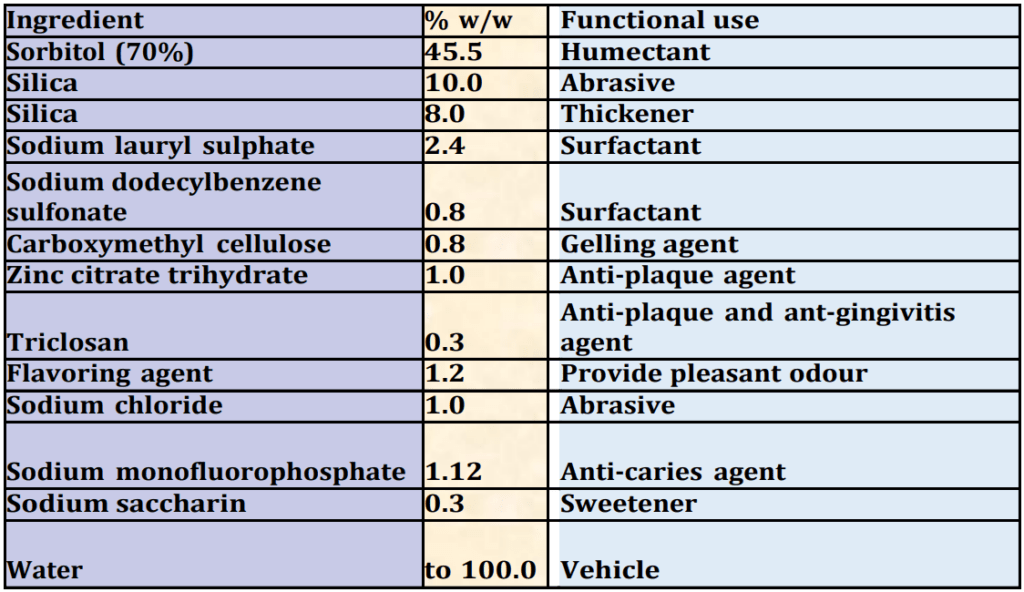
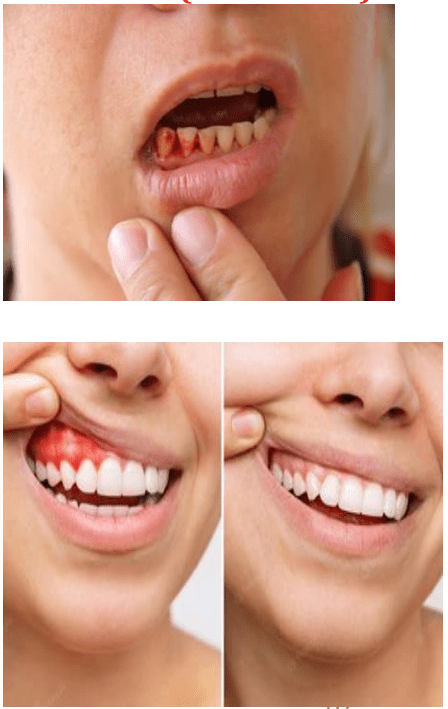
FORMULATION EXAMPLES OF TOOTHPASTE FOR SENSITIVE TEETH
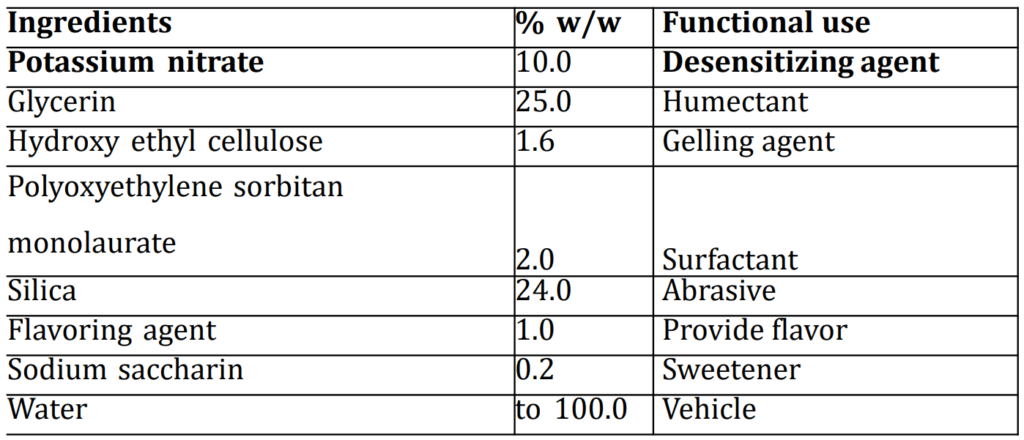
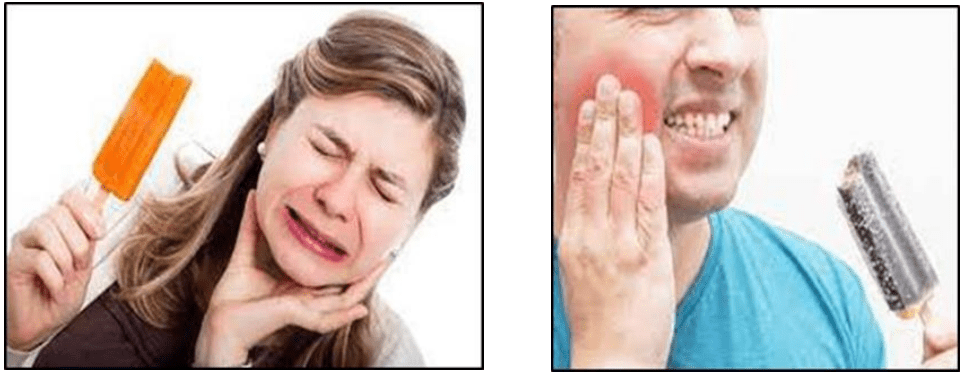
FORMULA OF TOOTHPASTE FOR TEETH WHITENING
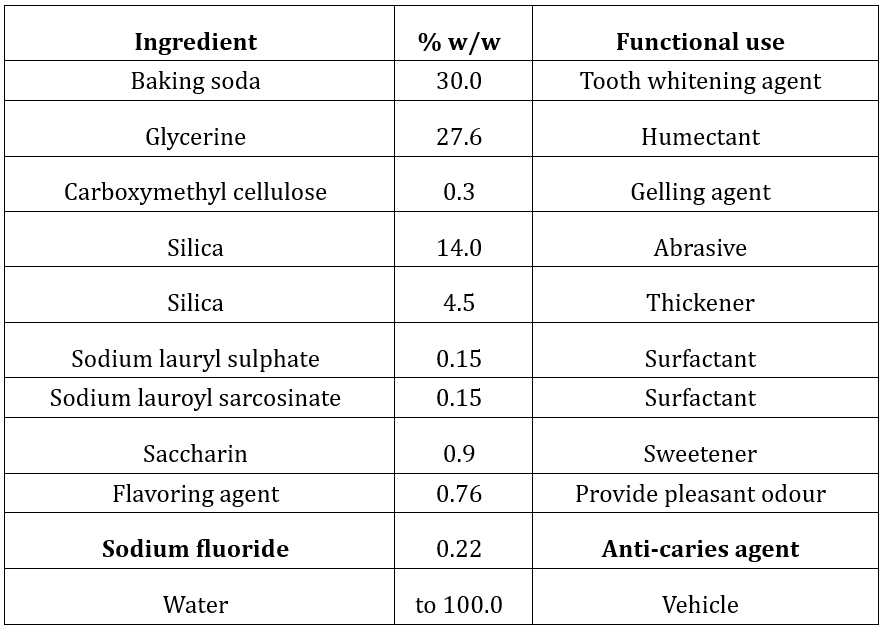
MOUTHWASHES
Definition of mouthwash
Mouthwashes, (also called mouth rinses or liquid dentifrices) are specially formulated clear solutions that are aimed to refresh the breath by vigorously swishing around the entire mouth followed by expectoration (spitting out).
- They comprise aqueous-alcoholic solutions of essential oils designed to have a good aroma and impart a refreshing and delightful flavor during and immediately after use.
- Most of the mouthwashes have been formulated as ‘ready for use’, while some mouthwashes are prepared in ‘concentrated form’ and are intended to be used after dilution appropriately as per the directions given on the label

Functions of mouthwash
The main functions of mouthwash are
- It improves oral hygiene and health
- kills germs, reduces plaque, and prevents gingivitis
- reduce oral discomfort,
- strengthen enamel,
- provide moisture to oral tissues,
- and fight bad breath (halitosis).
FORMULATION INGREDIENTS OF MOUTHWASH
- Solvents
- Flavors
- Sweeteners
- Humectants
- Surfactants
- Colorants
- Buffers
- Preservatives
- Other ingredients
SOLVENTS: Solvents function as a vehicle for the other ingredients in the formula. Normally, two main solvents are used in mouthwash formulations, water and alcohol (i.e., ethanol).
FLAVORS: The essential feature of a good mouthwash is its flavor so that it tastes good and also encourages usage by the consumers. Examples of ingredients include mint, menthol, peppermint oil, eucalyptol, methyl salicylate, thymol, and bubble gum.
SWEETENERS: These are usually added to mouthwashes to adjust the desirable taste of the formulation. The most widely used artificial sweeteners are sodium saccharin, sucralose, and potassium acesulfame. Sugar alcohols like mannitol, sorbitol, and xylitol are another class of sweeteners that can be used as sugar substitutes.
HUMECTANTS: These are used in mouthwashes to support the solubilization of flavors, modify the mouthfeel, and increase the osmotic pressure of the mouthwash to decrease the risk of microbial growth. For example, glycerine, sorbitol, hydrogenated starch, hydrolysate, propylene glycol, and xylitol.
SURFACTANTS: Surfactants are necessary for mouthwashes to solubilize the flavor oils and other non-water-soluble ingredients to Obtain a clear product and give stability to the product. They also provide little foaming for the product and with this action, they contribute to the cleansing effect of the product.
Various non-ionic surfactants are used in mouthwashes such as poloxamer 407, poloxamer 338, and poloxamer 124, polysorbate 80.
COLORANTS: Colorants are also an important part of mouthwashes though it is a minor ingredient of the formulation. Only a tiny amount of water-soluble dyes are used and colors may vary from blue to green, purple, or • yellow and red.
BUFFERS: Buffers are used in some mouthwash formulations to maintain the pH within a narrow range to help stabilize or improve the efficacy of certain ingredients. Common buffering systems used are benzoic acid/sodium benzoate, phosphoric acid/sodium phosphate/disodium phosphate.
PRESERVATIVES: Preservatives are used in alcohol-free mouthwashes to prevent or inhibit bacterial growth during the manufacturing process and throughout the product’s shelf life. Common preservatives used in mouthwashes include methylparaben and propylparaben, potassium sorbate, benzoic acid, and sodium benzoate.
FORMULA FOR ALCOHOL-CONTAINING MOUTHWASH
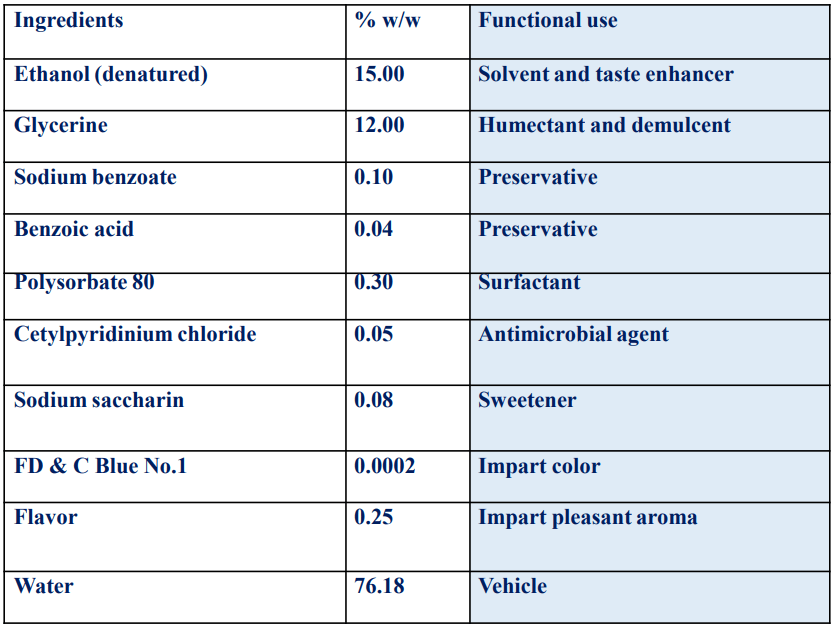
Make sure you also check our other amazing Article on: Calibration Of Measuring Glassware
